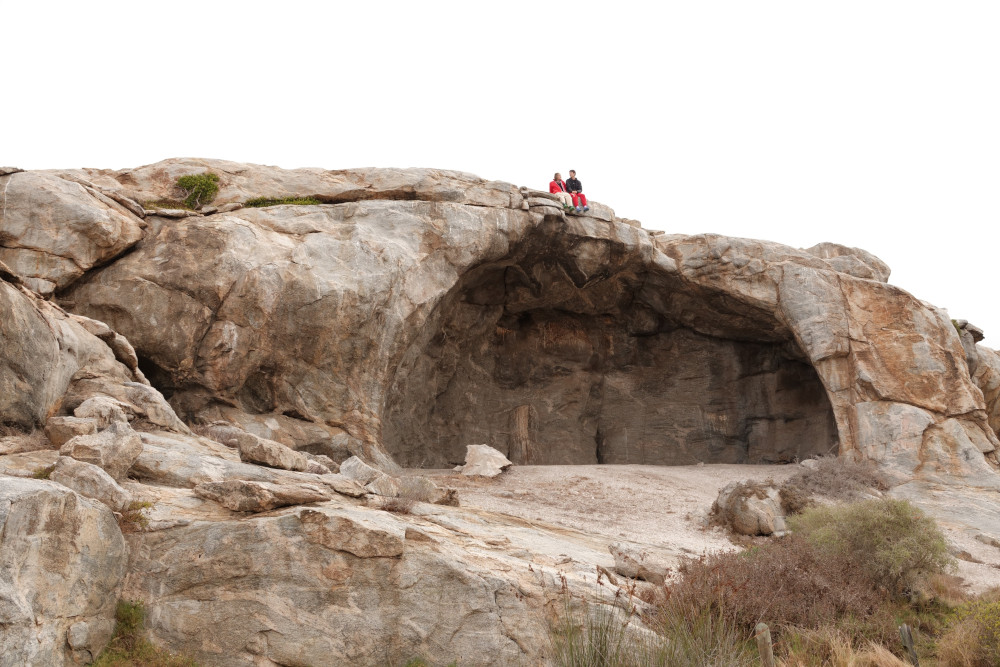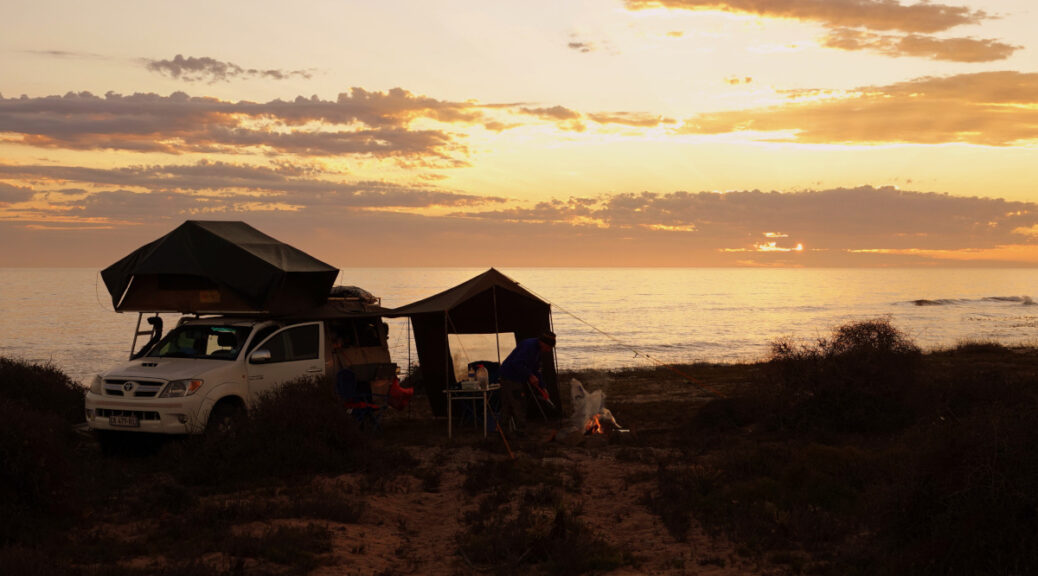Namaqualand’s shoreline is marked by pretty bays perfect for pitching your tent. With no electricity or running water, camping along the west coast is a wild experience. By Karin Theron
There is only one thing we like more than camping: wild camping! We love the freedom it gives you and the fact that you have pristine places to yourself. I guess we must be quite selfish nature lovers…
On our overland trip to Ethiopia in 2015 we wild camped as often as we could, setting up camp wherever we wanted. In South Africa, however, it is difficult to find places where you can safely pitch your tent on the spot that appeals to you most.
Once we learned from fellow travellers that there is a stretch along the west coast where you can camp in this way, we knew we had to go. We started doing our homework so we could go and see it for ourselves. As it turned out, the coast between the Olifants River (near Lutzville) and Spoeg River (near Hondeklip Bay) consists purely of off-grid camping.

The Tracks4Africa perspective on wild camping
The true definition of wild camping is pitching your tent wherever you like in the wild. In reality, it is not always quite so simple. Unless you are in a truly remote area, it is customary to request permission from the nearby community. If you’re in an area where wild camping is not permitted, respect the rules.
Because it is a privilege to camp is an untouched environment, it brings with it certain responsibilities. Everything you bring into a wild campsite should make its way out with you. Follow the unwritten rule to leave only footprints. Unfortunately, not all who wild camp go about it in this way.
For this reason, Tracks4Africa does not indicate spots for wild camping, but does list bush campsites. These are off-grid but designated sites where you can feel one with nature. Without even the basics, like a pit toilet or water supply, these campsites are strictly for the self-sufficient. The Namaqua coastline offers several such campsites: these are cleared and flattened areas, but without facilities.
Camping along the coast
For many decades, families from the surrounding Namaqualand farms used to trek to the seaside for their annual holiday. Over the years they have informally laid ‘claim’ to their campsites. Some have built a wind shelter from stones and a fire pit, while others have even erected long drop toilets. These families typically congregated in spots named after somebody, like Gert du Toit se Baai, Brand se Baai and Kwass se Baai.

Today the section between the Groen River and the Spoeg River is proclaimed as Namaqua National Park. The section just south of the Groen River belongs to Waterval Farm. Between Brand se Baai and Waterval lies another farm (we could not discover its name) that allows people to freely camp on their property. Even though Mineral Sands and Tormin Mines have mining rights in the area between Gert du Toit se Baai and Brand se Baai, people are still permitted to wild camp here. Note that the area from Tormin Mine to Gert du Toit se Baai is off-limits due to mining activities.
Of course, you need to be self-sufficient if you want to do a trip like this. Most importantly, you must be able to carry sufficient water. We managed to ration ourselves to 14 litres per day for washing, cooking and drinking between two people. That included water for a basin wash for each of us. Also, for this stretch you need a 4WD as there are patches of deep sand. Perhaps the most important thing to get right is the weather. It is best to avoid the strong southeast winds and the damp foggy days, neither of which is easy.
Finding the perfect bay
After two nights at Strandfontein and a visit to the mouth of the Olifants River, we made a quick stop in Lutzville to stock up on fresh food. Then the fun really started! From Koekenaap we took the gravel road west to the coast.
There are several campsites at Gert du Toit se Baai to choose from and the pools along the bay have provided many a tasty crayfish dinner. Outside school holidays and long weekends you can pretty much take your pick. During peak periods, you shouldn’t be too surprised if the family who laid claim to the sea plot asks you to move.
Tracks4Africa travel tip: When camping at Gert du Toit se Baai and Brand se Baai during holiday periods, check in with other campers before setting up. They will be able to tell you if any regulars are due or have left already. The gentleman’s agreement holds that the families who have been camping here for decades have first dibs.


In the area between Gert du Toit se Baai and Brand se Baai there are a myriad of small roads criss-crossing down to the sea. Every now and then you will see a spot that is leveled and graveled, with a pit toilet, where someone has ‘developed’ the spot. However, this is a long stretch with plenty of little bays to choose from to set up camp.
Just north of Brand se Baai you enter private farming land. Astonishingly, they allow people to camp on their property. You should respect the owners by adhering to the few rules they have. Since a section of the farm has been rezoned for camping, there are designated sites. However, it is still completely undeveloped and camping fees are minimal.



As we continued north, we passed through Waterval Farm. In recent years they have started to charge visitors a camping fee and request that you only camp at named campsites. These have interesting Afrikaans names like Skurfbaai, Lang Gert, Stinkgeut, Volwaterbaai, Hoogstaan and Sewejaarskop.
Coastal camping in Namaqua National Park
Shortly after the Groen River Lighthouse, you will enter the gate to the coastal section of Namaqua National Park, the jewel of west coast camping. Although not technically wild camping, since there are designated stands, it is completely off-grid.

There are eleven bays with varying numbers of campsites, all situated within a stone’s throw of the sea. Each campsite has a half-moon stone wall with a fire pit and a shared eco loo. This is the neatest, non-smelling pit toilet that I have ever come across. There are no other facilities at the campsites.
Apart from steenbok, oryx, bat-eared fox and ostrich, several smaller animals like meerkat, mongoose and mice are found in the park. It also boasts a large number of bird species, especially a variety of raptors. The bird hides at the Groen River and Spoeg River estuaries are worth a visit. We spent hours photographing the flamingoes (both the Lesser and Greater Flamingo), and other water birds.
From the north gate of the coastal section of the park, a good gravel road will take you to the fishing village of Hondeklip Bay. Here we camped at Honne Pondokkies, the only decent campsite in town. However, to be honest, after the pristine natural beauty of the park, our last stop was a bit of a disappointment.

What you need to know
- Lower your tyre pressure to at least 1.5 bar because there are stretches of deep sand. Don’t forget to pack your tyre compressor so you can inflate your tyres again.
- Bring your own wood, food and water.
- Take shade cloth along so you can build yourself a wind shelter if the wind is unpleasant. When you set up camp, always keep the wind direction in mind.
- In the south, the nearest town for shopping and fuel is Lutzville. In the north, you can do some basic shopping at Hondeklip Bay, but the nearest fuel is at Koiingnaas.
- You may get patches of cellphone signal, but rather be prepared for no signal.
- You can buy wood, ice and drinking water at the Groen River entry gate to Namaqua National Park.
- You have to bring your own water but if you are in dire need in Namaqua NP, you can prevail on the park rangers who collect the garbage daily. They may be able to fill up your water can at Delwers Camp, the only site with water tanks.
- At sites with no pit latrines, use a spade for ablutions and put toilet paper in a bag to burn.
- Leave no trace of your stay: remove all your rubbish when you leave. Much of your trash can be burnt in your campfire, but metal and glass will need to be driven out.
Also read: Bathroom trivialities when you camp

Want to tackle an overlanding trip to the secluded bays of Namaqualand? Tracks4Africa has you covered, with our GPS Maps, South Africa Paper Map and Traveller’s Atlas Southern Africa. Why not try out the Tracks4Africa online trip planner? For an introduction to the web-based route planner and a guide on how to use it, watch our YouTube video.

